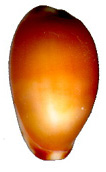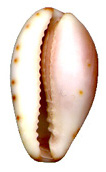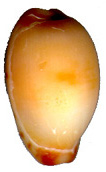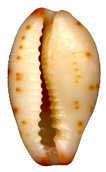| According to the great mass of unearthed historical relics in North China at archaeological sites of the Shang Dynasty period. Cowrie shells were proved using as media of exchange during Shang Dynasty (1600~1100BC). Because sea shells were pretty and easy to carry as well as easy to count. Sea shells did not naturally exist in Central China, they were imported from the coast of South China or Indian Ocean. |
Extremely Rare A ~ Very Rare B ~ Rare C ~ Not So Many D ~ Common E
| No. 033 | 
|

|
Cowrie shells were used as media of exchange and equivalents in the course of repeated exchanges during Shang Dynasty in ancient China. Inscriptions on the oracle bones and the bronze vessels always contain records about grants or gifts of sea shells in numbers of "P'eng".  "P'eng" was the basic unit of cowry money, comprising a strings of ten shells or "double strings". Cowrie Shells are about one and half centimeter or two long, have a hard and gleaming surface. Their surfaces look like porcelain and each of them has a the wrinkled little "mouth". Cowrie Shells are actually very comman for those who live near seaside, and it is difficult to understand why they were so lucky as became the first coinage in the ancient China. "P'eng" was the basic unit of cowry money, comprising a strings of ten shells or "double strings". Cowrie Shells are about one and half centimeter or two long, have a hard and gleaming surface. Their surfaces look like porcelain and each of them has a the wrinkled little "mouth". Cowrie Shells are actually very comman for those who live near seaside, and it is difficult to understand why they were so lucky as became the first coinage in the ancient China. [The use of shells as media of exchange had lasted until 1647AD in Yunnan province, when the peasant insurrectionary armies of Sun K'e Wang entered Yunnan province, shells were forbidden using as legal tender again. People used copper cash instead of shells.] Recently, I attended a workshop in Silvermine Beach Hotel in Lantau Island for a few days. We had beach walk in the early morning, I found that there were so many sea shells by the seaside. I easily picked up two cowrie shells and place them here showing to all of you. They are the same type as the ancient cowry money. | ||||||||||||||||||||||||||||||||||||||||||||||||||||||||||||||||||||||||||||||||||||||||||||||||||||||||||||||||||||||||||||||||||||||||||||||
| Place of origin: Hongkong | |||||||||||||||||||||||||||||||||||||||||||||||||||||||||||||||||||||||||||||||||||||||||||||||||||||||||||||||||||||||||||||||||||||||||||||||||
| Length 19 mm | |||||||||||||||||||||||||||||||||||||||||||||||||||||||||||||||||||||||||||||||||||||||||||||||||||||||||||||||||||||||||||||||||||||||||||||||||
| Wt. 1.0 g. | |||||||||||||||||||||||||||||||||||||||||||||||||||||||||||||||||||||||||||||||||||||||||||||||||||||||||||||||||||||||||||||||||||||||||||||||||
| Rareness E | |||||||||||||||||||||||||||||||||||||||||||||||||||||||||||||||||||||||||||||||||||||||||||||||||||||||||||||||||||||||||||||||||||||||||||||||||
| No. 034 | 
|

|
|||||||||||||||||||||||||||||||||||||||||||||||||||||||||||||||||||||||||||||||||||||||||||||||||||||||||||||||||||||||||||||||||||||||||||||||
| Place of origin: Hongkong | |||||||||||||||||||||||||||||||||||||||||||||||||||||||||||||||||||||||||||||||||||||||||||||||||||||||||||||||||||||||||||||||||||||||||||||||||
| Length 20 mm | |||||||||||||||||||||||||||||||||||||||||||||||||||||||||||||||||||||||||||||||||||||||||||||||||||||||||||||||||||||||||||||||||||||||||||||||||
| Wt. 1.3 g. | |||||||||||||||||||||||||||||||||||||||||||||||||||||||||||||||||||||||||||||||||||||||||||||||||||||||||||||||||||||||||||||||||||||||||||||||||
| Rareness E | |||||||||||||||||||||||||||||||||||||||||||||||||||||||||||||||||||||||||||||||||||||||||||||||||||||||||||||||||||||||||||||||||||||||||||||||||
 (The Historical Currencies of Yunnan), 1989. ISBN7-222-00504-8/k.93
(The Historical Currencies of Yunnan), 1989. ISBN7-222-00504-8/k.93